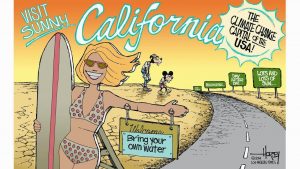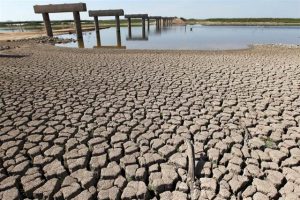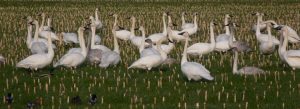Welcome to California, the place of sunny dreams, but this dream in the case of waterfowl has become a terrifying nightmare. The state of wetlands in the Central Valley was described as “discouraging” back in 1949 by Day, but it’s safe to say it’s got a lot worse, with over 95% now gone or threatened, something tells me we should have been paying more attention 65 years ago!

The ‘Pacific Flyaway’ is the migratory pathway millions of birds undertake every year from their northern breeding grounds in Canada and Alaska. It’s believed up to 60% of migratory birds stop off in the Central Valley for the summer time (Dasman, 1966).
But surely people aren’t the problem ?
Drought is a massive problem throughout the world but just to add to the pressure of an already warm climate let’s add the stress of agriculture and urban growth. California is the leading agricultural state in the USA (Mills, 1997) and with this, demand for water is high and legislation has made this a priority over wildlife.
Smart or Stupid, well that’s a personal opinion… but with only 25% of central valley having an “adequate water supply” we then go and take 87% of this and use it for irrigation (Kahrl, 1979). Oh and don’t forget the pesticides sprayed all over the crops polluting the water.
No wetlands, what’s the problem ?
So, wetlands are disappearing, but they aren’t that critical to a community? Wrong!
The Central Valley is ‘Feeding Ground Central’ for over 5 million bird, but with the loss of wetlands. The question is where do all these birds find food?
The options
They can overcrowd in the remaining wetlands, however, food limitations occur as early as mid winter/ early spring (Petrie et al., 2016). Flies and insects struggle to have successful hatching due to lack of stagnant water, and those within the sediment and plants desiccate. Meaning food sources of the waterfowl are greatly effected by this fragmentation. Oh and to top it off the rate of disease sky rockets with overcrowding. Cases have documented die offs of over quater of a million ducks as a result of avian diseases (Hunter et al., 1970).

Or
They can settle on agricultural land, shifting their habitat and dietary requirements. So it’s all fine, right? 50% of these migratory birds now rely on waste rice/grain crops for their energy source instead of plants and insects previously found in wetlands, they have learnt to exploit a new niche. Great!

So the community has changed, they found food so it’s all fine?
This really would be the ideal situation, Sadly, despite over coming dispersal barriers by flight, drought has greatly restricted the habitat and has drastically changed the community composition by desiccation and lack of hatching success of insects and flowering plants. The adaptation of diet change to exploiting crops still posses great risk as everything is still water dependant.
The effects on the community are already drastic but how far could drought really push the wildlife all over the world?
References
Day, A.M. (1949) North American Waterfowl. The stack-pole Co., Harrisburg, Pennsylvania, pp.363
Dasmann R.F. (1966) The Destruction of California, Collier Books, New York City, 10tth pp.203-223
Hunter, B.F., Clark, W.E., Perkins, P.J., Coleman, P.R. (1970) Applied Botulism Research Including Management Recommendations- a progress reports. California Department of Fish and Game, Rancho Cordova, California, USA. pp.37
Kahrl, W.L. (1979) The California Water Atlas, Governor’s Office of Planning and Research in cooperation with the California Department of Water Resources, Sacramento, California
Mills, P.K. (1997) Correlation Analysis of Pesticide Use Data and Cancer Incidence Rates in California Counties. Archives of Environmental Health : an international Journal. 53(6), pp.410-413
Petrie, M., Fleskes, J., Wolder, M., Isola, C., Yarris, G. and Skalos, D. (2016). Potential Effects of Drought on Carrying Capacity for Wintering Waterfowl in the Central Valley of California. Journal of Fish and Wildlife Management, 7(2), pp.408-422.
Word count :495
Recent Comments